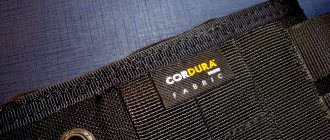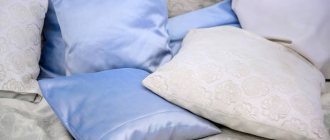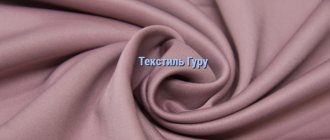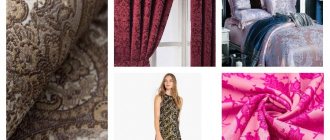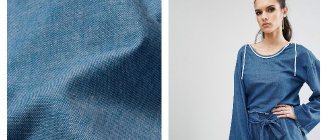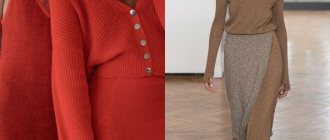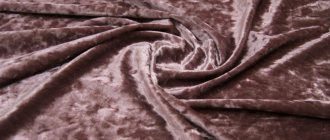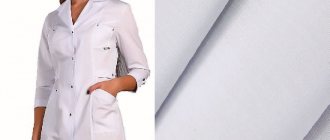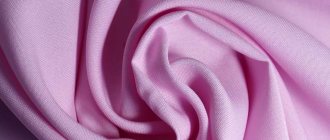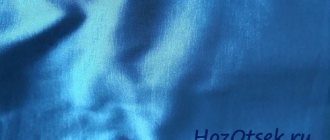Among beginning tailors, questions often arise regarding the properties and characteristics of materials. It is necessary to take them into account; the scope of application and practicality of the future product depend on this. What is light fabric is a question that often arises when choosing textiles. It should be noted that this is the name given to a whole group of paintings. What properties they have and how they differ from the main ones can be easily understood by reading the characteristics of fabrics with the prefix “light” in the name.
The meaning of “light” for fabrics
Translated into Russian, “light” means “light”. This term is used in relation to lightweight materials of different groups. The characteristics of light fabrics are similar in indicators to the properties of the original textiles.
A distinctive feature of the fabrics is reduced density and weight, increased elasticity. The material is soft, pliable, and thinner to the touch. Light fabric is a lightweight analogue of textiles made from natural, artificial and synthetic fibers in various variations.
General characteristics
Textile materials with a lightweight structure are produced by two types of weaving:
- Linen (simple). Fabrics are characterized by a textured surface.
- Twill. Fabrics with a smooth (satin) front side.
The material, unlike the original fabric, stretches better, but at the same time retains the shape of the product. Dyeing of finished textiles is carried out at the final stage of finishing.
The description of light fabric is given in the summary table, which shows the properties of a group of lightweight types of textiles:
| Characteristics | Indicators | ||
| Raw material type | Natural, synthetic, artificial and mixed compositions | ||
| Density, g/sq. m. | Less than in the original samples (from 70) | ||
| Structure | Smooth or embossed | ||
| Weaving method | Plain or twill | ||
| Water resistance | Mixed | Natural | Synthetic |
| Average | Low | Above average | |
| Hygroscopicity,% | 8 | 12 | 6 |
| Moisture absorption rate | Average | High | Low |
| Air exchange | Average | High | Short |
| Vapor permeability | good | Excellent | Weak |
| Electrification | No | No | Eat |
| Coloring methods | Plain-dyed plain and printed fabrics | ||
| Side | Single- and double-faced canvases | ||
| Manufacturer | China | ||
| Price | Affordable, lower than the cost of the original canvas | ||
| Types of fabrics | Teak, Pikachu, Satori, Boston, Barbie, velor, etc. | ||
Possible compositions
The group of materials designated light is diverse in composition. The fabric is made from natural fibers of plant origin (linen, cotton), in the form of mixed samples with the addition of artificial or synthetic threads. In recent years, the range of lightweight materials consisting of chemical raw materials has increased significantly.
Raw materials used in the composition in different combinations:
- cotton;
- linen;
- viscose;
- polyester;
- elastane.
Do light fabrics stretch?
For light canvases, the relevant question is whether the lightweight version stretches or not. Elasticity directly depends on the characteristics of the original textile. To produce a lightweight version, short fibers are combed out to increase length. On the automatic line, parameters are set for the production of fabric with a lower density.
To create fabrics with high elongation rates, stretch fibers are introduced into the composition. But even without them, lightweight materials can demonstrate increased elasticity if the original version has this ability.
“Light +” lamps: how does it work, where is the truth and where is the deception?
So-called “high brightness” lamps regularly generate controversy in the automotive community. People do not fully understand their essence and the principles embedded in the design - phrases are constantly heard that these lamps blind oncoming drivers, that they violate Ohm's law and that this is generally a fiction... Manufacturers are partly to blame for the misunderstanding, as they initially did not clearly and clearly explain the essence of this directions to consumers, but only began to increase the “plus” percentage year after year. “Wheels” proposes to stop the holiwars once and for all by revealing all the secrets of the “light +” lamps.
So, let's go!
Power
The power of an incandescent lamp is proportional to its brightness. And how many headlights were damaged by lamps of increased power compared to the standard ones, inserted at random, thoughtlessly - I can’t count them...
A car headlight is designed for a strictly defined lamp power, and it is impossible to increase it by simply inserting a lamp with the same base, but with increased watts, into the socket. Everything deteriorates - glass, reflector, wiring, relay. As the power increases, the current consumption and heat generation increase: the polycarbonate glass of the headlight overheats and becomes cloudy, the wiring insulation softens from the extra amperes, the wires in the harness become short-circuited….
Therefore, high-brightness lamps are NOT MORE POWERFUL! Their power strictly corresponds to the standard one. If you have, say, a regular 55-watt H7 lamp in your headlight from the factory, then ANY high-brightness lamp that has ECE approval (even “+20%”, even “+200%) will also consume 55 watts from the on-board network watt!
Brightness
Many of us in our barefoot childhood believed that “the cooler the car, the more powerful everything about it!” A stronger engine, brighter headlights, and so on... As for the engine, that’s probably true, but this doesn’t work with headlights...
The power of headlight bulbs (and the resulting brightness) are strictly standardized at a compromise level - so that the road is sufficiently illuminated and drivers of oncoming cars are not dazzled. Increasing the brightness at will is strictly prohibited, and not a single automaker or auto lamp manufacturer does this. Both a high-power lamp and a headlight with such a lamp will never pass certification, which is very strict. The number of lumens of luminous flux normalized by international standards cannot be exceeded.
The power is the same, the brightness is the same... And so we come to a paradoxical conclusion, stepping on the thin ice of holivars and srachs: if the power and brightness of “light +” lamps are the same as those of conventional lamps, then where is the profit hidden? for the driver?! Why was everything started and aren’t we being deceived?!
Take your time - it's not that simple!
So what is the difference between a regular lamp and a “light +” lamp?
The so-called lamps with increased brightness differ from ordinary lamps in two main elements. The design of the filament and glass bulb. They are completely different!
The filament of a high-brightness lamp is thinner. Accordingly, it heats up to a higher temperature and emits a luminous flux of increased intensity. Nevertheless, we emphasize that the electric power of the lamp remains unchanged! The design of the filament, its geometry and alloy material are selected so that the power is similar to a standard lamp, and the high-brightness lamp does not have any special features or nuances of use - it simply changes from one to another.
© OSRAM
The bulb of the high-brightness lamp is also different. It has a special gradient glass coating. In essence, it is a kind of filter mask that transmits more intense light radiation only where it is needed, strictly within the boundaries of a standardized and normalized light beam.
Why does the efficiency of headlights noticeably increase with “light +” lamps, but there is no increase in overall brightness, the consequence of which cannot but blind oncoming drivers? Because many people confuse brightness and illumination... And even general - with zonal.
All lamp manufacturers follow the safety standards adopted by the ECE (Economic Commission for Europe). Standards require a lamp of each standard size not to exceed a certain maximum luminous flux, measured in lumens inside a special control and measuring spherical chamber, in the center of which the lamp is placed during examination. The lamp emits on almost all sides (well, except for the base), and the luminous flux at each point of the test sphere is measured by sensors and summed up. For example, for the same very common H7, its total should not exceed the permissible permitted 1500 lumens.
When a lamp of increased brightness, “light +”, is placed in the center of this sphere, it also shows the same permitted 1500 lumens - there is no excess! And this happens precisely thanks to the filter mask on the flask. If the mask were absent, the total luminous flux, of course, would be higher than permitted and would blind the oncoming traffic... But the filter dims the light in those sectors of radiation where it is not needed, letting in the necessary ones. As a result, it is the useful radiation of the lamp that increases in comparison with a lamp of a standard design.
So what is "+"?
“Plus” percentages are not a completely understandable thing, and here the manufacturers of such lamps at one time did a little less work in terms of informing the audience of car owners. Many people consider this to be a percentage of brightness, which is certainly not true.
Interest “+ХХХ” is a rather complex complex value. The comparison is made with the minimum acceptable light from a certain conventional lamp according to safety standards, but the “plus” percentages are calculated based on measurements at four specific points of the cut-off line of the luminous flux. Therefore, of course, “+100%” or “+150%” is not an increase in the brightness of the headlights by two or two and a half times, but an increase in the effect of illumination exactly where it is usually insufficient, on the cut-off line. This increase also affects the maximum range of the area illuminated by the headlights - these numbers are indicated on the packaging of the lamps in meters, but you must understand that this is not a guaranteed clear increase, but the numbers “UP TO xxx”. Because this increase is individual and depends on the original design of the headlights of a particular car and on their technical condition - the quality of the reflector, the transparency of the glass, etc.
© OSRAM
Life time
The lifespan of “light+” lamps is an endless source of controversy, raging everywhere from garages to car forums. The main complaint about such lamps is “they burn out quickly,” and car owners, having purchased an expensive product, feel deceived... Why does this happen and is there any deception here?
The laws of physics are inexorable, and if the filament of a “light +” lamp is thinner and heated to a higher temperature, then it actually lasts less than the filament of a similar conventional lamp - thicker and less hot. No other way!
The service life of “light +” lamps is approximately half that of classical lamp designs: on average approximately 250 hours versus 500 hours. This is usually not hidden and is indicated on the packaging, but buyers rarely pay attention to such “little things”, which ultimately often leads to disappointment...
You need to understand the following. “Light +” lamps are the ONLY way to legally and safely make your headlights more efficient for your car and others. Well, in any case, the only budget one, for sure. Because completely replacing halogen headlights with xenon ones taken from a more expensive (or more recent by years) modification of your car model is an extremely expensive option. And if you really drive a lot and often in the dark, then reducing the service life of the lamps is a conscious compromise in favor of increasing traffic safety and reducing driver fatigue. In the case of traditional halogen headlights, there is simply no ideal option - either improved illumination and slightly more frequent lamp changes with “light +”, or standard light and durability with lamps of a conventional design.
Also, “light+” is able to help out those who even had serviceable new headlights that initially did not have good light - well, that’s just how they were designed, this often happens in the budget class of cars... And they are even more useful for those whose headlights are already old and worn out, with cloudy glass and reflectors that have partially lost their specularity. If for some reason it is difficult to change such headlights, you can return them to characteristics close to the factory ones with more efficient lamps.
Osram Night Breaker 200
Well, let’s sum up the story about high-brightness lamps with the announcement of a new product - the most efficient lamps that appeared recently as part of OSRAM’s efficiency-increasing technology, Night Breaker 200. The increase in illumination for these lamps is a record +200%.
“All of the above exhaustively characterizes the “light+” lamps of most manufacturers. The main thing is to initially understand their features and set your priorities correctly. And then the benefits of more efficient headlights for you will consciously outweigh the forced need for slightly more frequent replacement of lamps. High-quality light will allow you to freely choose the permitted speed limit, and not slow down out of the blue due to poor lighting of the highway and roadside,”
– OSRAM technical specialist Artem Nuriakhmetov tells Kolesam.
“ Well, I’ll still briefly supplement this educational program with some individual features of the OSRAM Night Breaker 200 lamps!
In addition to two key technical solutions that distinguish them from conventional lamps (filament and bulb), the Night Breaker 200 uses many more small auxiliary technologies, which together make it possible, with such a high increase in efficiency, to maintain the service life of the Night Breaker 200 at the level of the previous generation Night Breaker " This is an increased pressure and volume of halogen in the flask, which allows for improved regeneration of the tungsten filament (an effect that has long been known for any halogens, and not just “light+” - the deposition of the evaporating metal of the filament back onto the filament). The filament is made more vibration-resistant - as much as possible today for a thin filament operating at elevated temperatures. Another innovation - in addition to the usual halogen, xenon has been added to the lamp bulb! No, of course, this lamp did not become a xenon lamp - a gas-discharge xenon lamp has a completely different design and operating principle, but xenon, as it turned out, can be very useful in a halogen lamp! Xenon atoms are large in size, and, “enveloping” the filament, they do not allow the detached tungsten atoms to fly far from the base, accelerating the regeneration process and working as a kind of “gas heat insulator”, without releasing excess heat from the highly heated filament onto the surface of the bulb.
Night Breaker 200 light is 20% whiter than standard halogen lamps - the color temperature is increased (up to 3700 Kelvin for Night Breaker 200 H7 lamps and 4050 Kelvin for Night Breaker 200 H4 lamps), which creates a more comfortable illumination for the eyes. And the range of the illuminated area is increased by a distance of up to 150 meters (depending on the type and condition of the headlight, of course).
OSRAM Night Breaker 200 is available in the most popular sizes – H4 and H7. And, by the way, they are reliably protected from counterfeits - these lamps in double plastic boxes are covered by the proprietary OSRAM Trust authentication system, which allows you to detect a counterfeit even at the purchase stage! To do this, we go to www.osram.ru/trust, enter the 7-digit code from the packaging in a special window and click “Check”. This is the first stage. In it we receive confirmation of information about the product - the name of the model and product line. After which the service gives you a second code - it should be on the lamp base. We compare the received code with the inscription on the lamp, and if everything matches, we have 100% original!
Application of fabrics
Despite the thinness and lightness of light fabrics, they are strong and durable. They are indispensable for sewing summer clothes, the comfort of which is ensured by good air exchange and vapor conductivity.
From light material I sew such things as:
|
|
In addition to sewing products, the fabric is used for interior decoration, for upholstering furniture and making covers, curtains, and drapes.
Materials are divided into three subgroups: stretch, knitted, fire-resistant.
What is light fabric: reviews
When choosing clothes or home textiles in a store, we often pay attention to the composition of a particular product. One of the names that we can see on the tag is light fabric, reviews of which you will find in this article. They will help you decide whether products made from this fabric are suitable for you.
Rita “I have a dress made of light fabric, I can only leave positive reviews! It’s light, airy and breathable, I think it’s the best option for the summer! I took it with me on vacation; thanks to its hygroscopicity, it was very comfortable and not at all hot.”
Ivan “Recently, my wife and I were looking for new bedding. I wanted to buy something new and beautiful. We found an interesting set in one store, but it said light and we had a question, what kind of fabric is light? We couldn’t find any reviews or photos, so we decided to just take a chance and buy it. And we were right: the linen turned out to be very pleasant and soft, but despite this, very durable.”
We will tell you later whether a pleated skirt can be washed.
Types of light fabrics
Lightweight fabrics are used for sewing clothing, interior items, and upholstery. The properties and purpose of such textiles depend on the original ones. The output is fabrics of similar quality, but lighter, capable of ensuring air conductivity.
There are a lot of light types of fabrics. The characteristics of the most popular ones are given below.
Satori
Material density 115 g/m2. m. is used in sewing summer clothes and for the manufacture of workwear: suits, gowns and hats for doctors and catering workers.
The composition of the fabric is mixed: 50% cotton and the same amount of polyester. Satori is produced using a twill weave, in which cotton threads form the back side, and synthetic threads form the front side. This results in a smooth fabric with high comfort levels.
The surface is resistant to dirt. The material is hygroscopic, breathable. The canvases are plain-dyed, plain, mostly light shades. The disadvantage of the material is the relatively high cost in the group of light fabrics.
Barbie
The lightweight version of Barbie is made from cotton and elastane (spandex) fibers. The material is durable, shape-resistant, does not wrinkle, drapes well and does not form saws. In appearance it resembles crepe. Stretches well in two directions.
Barbie is used to make summer clothes and linen items. The canvases are plain-dyed and printed. The color palette is varied.
Teak
Teak is a dense light fabric. It is made from flax and cotton fibers, taken in equal quantities, woven in a linen manner. Shows a density of 140 gsm. m. (standard - 170 g/sq. m.).
The stretchability of lightweight teak does not change. The disadvantages include shrinkage and the ability to wrinkle. Clothing, bed linen, and interior items are made from textiles.
Boston
Unlike classic Boston, made from wool fibers, light is a blend of cotton (35%) and polyester (65%). Soft, wear-resistant fabrics have the ability to maintain their appearance and color richness after repeated washings. Used for making suits and workwear.
Pikachu
Pikachu belongs to the group of polyester costume materials. Density - 200 g/sq.m. m. Standard fabric does not allow air to pass through well; to improve properties, viscose is added to the composition (up to 30%).
A small percentage of spandex allows for a good fit. Pikachu is used in sewing light suits, dresses, skirts, trousers, and blouses.
Velours
Light velor is widely used for upholstery of upholstered furniture. The material looks impressive, lasts a long time, and does not pill. The composition of this synthetic fabric is 100% polyester. Soft, pleasant to the touch.
Despite its lightweight structure, velor demonstrates abrasion resistance of 50,000 cycles on the Martindale scale. Material density 360 g/m2. m.
Bodyflex
Bodyflex is a synthetic fabric that varies in fiber composition. Unlike supplex, it is less stretchable (the elasticity coefficient is 10%, for supplex it reaches up to 300%). The beautiful appearance ensured the popularity of the material.
The composition includes microfiber and elastane. Sometimes nylon and lurex are added. Used for sewing tight-fitting trousers, dresses, and turtlenecks.
Energy
Energy presents upholstery fabric with abrasion resistance of up to 40,000 cycles. Made from polyester, polyacrylic and spandex. It has a fleecy front side, reminiscent of velor. Soft and elastic energy is used for sewing covers and interior decoration.
Bengalin
In the classic version, bengalin is made from cotton and a small amount of elastane fibers. The beautiful flowing material is pleasant to the body, plays with color, and is opaque.
In a lightweight version, a combination of viscose and nylon threads is used. This material is called Euro Bengal soft. Women's clothing models are made from it.
Light fabric: description and characteristics of different options
In this article we will look at four quite popular options.
Kinds
The first one is teak light fabric, let's talk about its composition and characteristics. Teak is a natural material made from cotton or linen threads. Its main quality is its high density, up to 160 g/m2. But there is also a lightweight version, here the density does not exceed 140 g/m2.
In addition, standard teak is produced using the twill or satin weave method, and in the case of the light version, plain weave is used. We talk about what teak material is in a separate article on the website.
Bed linen, work clothes, curtains and drapes are made from “light” teak.
The characteristics of matter correspond to the properties of all natural materials:
- Breathability
- Hygroscopicity
- Environmental friendliness
- Strength
- Durability
Additionally: Nylon - composition and properties of fabric, find out in another article.
The second type is satori light fabric.
Satori is a mixed fabric, consisting of 50% cotton, 50% polyester. It is used for sewing workwear (medicine, light industry), so the standard version is quite thick - up to 145 g/m2. We talked about this material in more detail here.
But, since it is uncomfortable to work in thick clothes in the heat, or in the kitchen, where in principle it is rarely cool, manufacturers began to produce a lightweight version - 115 g/m2.
This variety retains all the positive qualities of the main version:
- Excellent breathability that allows the skin to breathe
- Softness, comfortable wearing
- Easy to clean, fresh dirt can be easily removed with a simple damp cloth
- Such products can withstand repeated bleaching and autoclave sterilization without losing either shape or color.
Thus, satori light fabric is perfect for clothing that will be used in non-standard conditions, but at the same time must always have a neat appearance. Our expert will tell you how to remove pomegranate juice stains.
The third type is Boston light. Boston is another type of material used for sewing workwear. If we look at history, the classic version of Boston is a woolen material with a twill weave.
But in our case, the composition is different - 35% cotton, 65% polyester. But the weave is still twill.
The usual type of such fabric is characterized by a density of 230 g/m2, a lighter version is 200 g/m2.
Yes, as you can see, even the lite version of this matter is still very dense. This is due to the fact that clothes are sewn from it, which will subsequently be subjected to repeated washing and will be exposed to various unfavorable conditions.
Start your business! Find out how to open a Wildberries distribution point.
If you sew a work overall from ordinary material, it will lose its attractive appearance almost instantly, but workwear made from Boston remains attractive for up to three years. But what other properties are characteristic of this matter:
- Very high strength and wear resistance
- Extensive color palette
- Doesn't wrinkle
- Pleasant to the touch and to the body
By the way, this material is the winner of the “Best Fabric of the Year 2011” competition.
The fourth type is Pikachu light. Pikachu light is an ideal fabric for a dress, suit, and, probably, for any element of a woman’s wardrobe. Read more about it here.
This is a synthetic material, it is made from polyester or elastane, but our “light” version includes viscose in the composition.
High density Pikachu - 350 g/m2 - is used for sewing classic business suits.
But from “light”, which is only 200 g/m2, you can sew light dresses, sundresses, and school uniforms. The material stretches perfectly and fits perfectly, which is so important for modern fashionistas. In addition, such an elastic fabric is very convenient to work with.
Care instructions
Care for lightweight products depends on the composition of the fabrics. Before you send the item for washing, you should carefully study the label and decipher the symbols indicated on it.
General recommendations include the following rules of care:
Washing is done separately. Natural cotton fabrics can be bleached. The rest must be washed at a temperature not exceeding 40 degrees using gel or liquid detergents.
Spin at medium speed for 10 minutes. Dry things flat out in rooms with good air circulation or in an open space (balcony, loggia).
Iron the product from the wrong side. Ironing can be replaced by steaming.
Dry cleaning is not permitted for light materials.
Light
I
1.
noun 1) a) light; lighting For example: bright / strong light - strong, bright light dull / faint light - dim, weak light harsh light - sharp light soft light - soft light electric light - electric light by the light of something - in the light of something to read by the light of a candle - read by the light of a candle Light flickers. — The light flickers. Light goes on. — The light turns on, lights up. — klieg light — neon light — overhead light — strobe light b) daylight; natural lighting Synonym(s): daylight c) dawn, morning dawn Synonym(s): dawn 2) a) celestial body (moon, sun, stars) b) fire; lit candle Synonym(s): candle c) lamp, lantern, spotlight For example: dome light - lampshade to turn the lights up - turn on the lights to dim the lights, to turn the lights down - dim the lights to extinguish / turn off / turn out a light - turn off, extinguish, extinguish the light to put / switch / turn on a light - turn on the light to shine a light on something - shine on something The lights are off / out. - The lights are turned off. The lights have fused. - The light turned off. The traffic jams were knocked out. 3) a) enlightenment, education Synonym(s): enlightenment b) truth Synonym(s): truth 4) fire, flame For example: to put a light to the lamp - light the lamp 5) window, enlightenment 6) luminary; celebrity Synonym(s): celebrity 7) a) (lights) used colloquially eyes, zenki, peepers b) outdated vision expression of the eyes;
lighting For example: bright / strong light - strong, bright light dull / faint light - dim, weak light harsh light - sharp light soft light - soft light electric light - electric light by the light of something - in the light of something to read by the light of a candle - read by the light of a candle Light flickers. — The light flickers. Light goes on. — The light turns on, lights up. — klieg light — neon light — overhead light — strobe light b) daylight; natural lighting Synonym(s): daylight c) dawn, morning dawn Synonym(s): dawn 2) a) celestial body (moon, sun, stars) b) fire; lit candle Synonym(s): candle c) lamp, lantern, spotlight For example: dome light - lampshade to turn the lights up - turn on the lights to dim the lights, to turn the lights down - dim the lights to extinguish / turn off / turn out a light - turn off, extinguish, extinguish the light to put / switch / turn on a light - turn on the light to shine a light on something - shine on something The lights are off / out. - The lights are turned off. The lights have fused. - The light turned off. The traffic jams were knocked out. 3) a) enlightenment, education Synonym(s): enlightenment b) truth Synonym(s): truth 4) fire, flame For example: to put a light to the lamp - light the lamp 5) window, enlightenment 6) luminary; celebrity Synonym(s): celebrity 7) a) (lights) used colloquially eyes, zenki, peepers b) outdated vision expression of the eyes;
sparkle in the eyes 9) a) look at the meaning of traffic light traffic light b) beacon, signal light Synonym(s): lighthouse, beacon c) automotive headlight, sidelight, car light signal For example: winking lights - direction indicator, maneuvering signal 10) ( lights) opinion, assessment, individual standards; system of principles 11) a) publicity (of information); publicity For example: facts brought to light - facts that have become known to come to light - to appear b) aspect; interpretation; statement of a question; perception For example: to put something in a favorable light - to present something in a favorable light Let's see the matter in a different light. - Let's try to look at this situation from a different perspective. For example: by the light of nature - intuitively to cast / shed light (up)on something - to shed light on something - see the light 2.
adjective 1) light, clear (about the room) For example: light airy room - bright spacious room 2) a) pale, dull Synonym(s): pale b) light (about the shade of color) For example: light blue - blue light green - light green light yellow - pale yellow 3) with a lot of milk or cream ( about coffee)
3.
verb;
past tense, past participle lighted, lit; the same as light up 1) the same as light up - to illuminate (a room); shine (to someone) Synonym(s): illuminate 2) a) light For example: She lit a candle. — She lit a candle. b) light up, light up Synonym(s): kindle 3) the same as light up a) glow, revive, illuminate For example: Her face lit. — Her face was glowing (with joy). Synonym(s): brighten b) to enliven For example: A smile lit her face. — A smile brightened her face. Synonym(s): animate — light up II 1.
adjective 1) a) light; lightweight For example: as light as a feather - light as a feather b) low-load capacity, designed for low weight For example: light truck - light-duty truck c) light (in relation to volume) For example: light metal - light metal light snow - light snow 2) insignificant, insignificant For example: light damage - minor damages, losses; minor damage light sleep - light sleep, dozing The loss of a job is no light matter. — Losing a job is not such an insignificant event. light punishment - mild, non-strict punishment light sentence - mild sentence - light rain Synonym(s): trivial 3) light, not burdensome, not difficult For example: light duties - light assignments Synonym(s): easy, simple 4) loose, loose (about soil) 5) fickle, frivolous, frivolous; cheerful For example: light woman - a woman of easy virtue to make light of - take lightly, carelessly towards (something), do not attach importance to (something) Synonym(s): light-hearted, amusing, funny, carefree, frivolous, sprightly, blithe 6) a) easily digestible, light (about food) For example: light breakfast - light breakfast b) the same as lite - light, lightweight (about products; with a reduced content of any components that are usually harmful to health) For example: light cream American English; used in the USA light, low-fat cream (18-30% fat content) light beer - weak, weak beer 7) a) fast, light (about movements) For example: She is a light dancer. — She dances very gracefully. Synonym(s): airy, graceful b) military affairs light, mobile For example: light automatic gun - light machine gun - light artillery linguistics a) unstressed (about a syllable, sound) b) weak (about stress) 9) cooking well-risen, light , airy (about the test) 10) indistinct, vague, unclear Synonym(s): faint For example: light in the head - feeling dizzy - light hand
lightweight For example: as light as a feather - light as a feather b) low-load capacity, designed for low weight For example: light truck - light-duty truck c) light (in relation to volume) For example: light metal - light metal light snow - light snow 2) insignificant, insignificant For example: light damage - minor damages, losses; minor damage light sleep - light sleep, dozing The loss of a job is no light matter. — Losing a job is not such an insignificant event. light punishment - mild, non-strict punishment light sentence - mild sentence - light rain Synonym(s): trivial 3) light, not burdensome, not difficult For example: light duties - light assignments Synonym(s): easy, simple 4) loose, loose (about soil) 5) fickle, frivolous, frivolous; cheerful For example: light woman - a woman of easy virtue to make light of - take lightly, carelessly towards (something), do not attach importance to (something) Synonym(s): light-hearted, amusing, funny, carefree, frivolous, sprightly, blithe 6) a) easily digestible, light (about food) For example: light breakfast - light breakfast b) the same as lite - light, lightweight (about products; with a reduced content of any components that are usually harmful to health) For example: light cream American English; used in the USA light, low-fat cream (18-30% fat content) light beer - weak, weak beer 7) a) fast, light (about movements) For example: She is a light dancer. — She dances very gracefully. Synonym(s): airy, graceful b) military affairs light, mobile For example: light automatic gun - light machine gun - light artillery linguistics a) unstressed (about a syllable, sound) b) weak (about stress) 9) cooking well-risen, light , airy (about the test) 10) indistinct, vague, unclear Synonym(s): faint For example: light in the head - feeling dizzy - light hand
2.
adverb 1) easily For example: to get off light - get off easily to tread light - tread lightly Synonym(s): lightly 2) lightly For example: to travel light - to travel lightly For example: light come light go - easily acquired, easily lived
III
verb; past tense, past participle lighted, lit 1) a) (light (up)on) unexpectedly come across, accidentally attack For example: His eyes lighted on a familiar face in the crowd. — Suddenly he saw a familiar face in the crowd. He lit upon an interesting idea. — An interesting thought accidentally occurred to him. b) (light into) to pounce on (someone) 2) a) to fall, to fall b) to unexpectedly collapse (about a blow) 3) obsolete to go down; descend, sit down (on something) Synonym(s): settle, alight, dismount - light out
